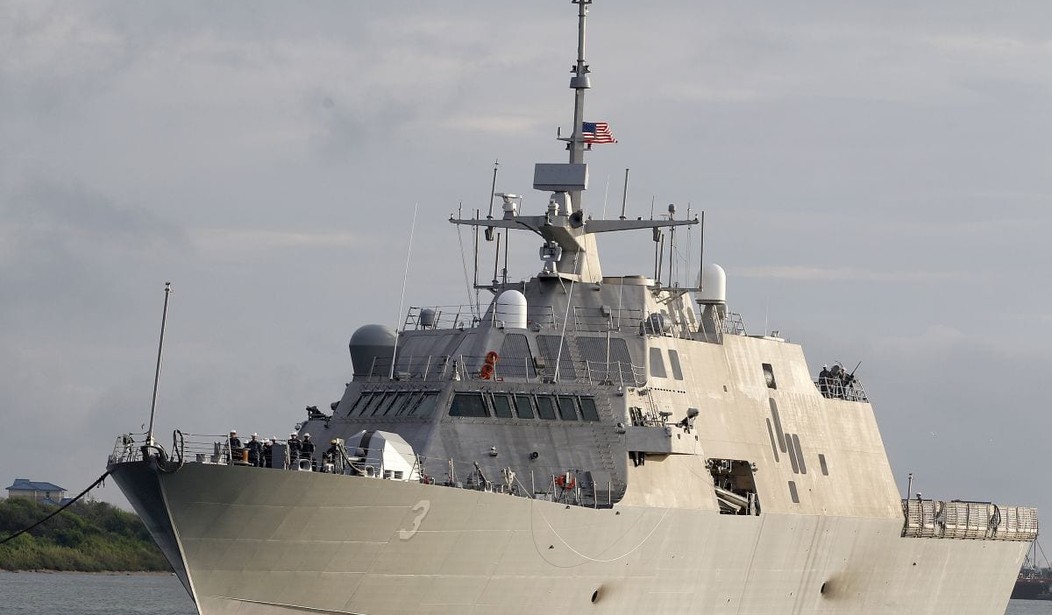“Behind schedule, hundreds of millions over budget, and incapable of conducting most of the basic missions it was intended to carry out.”
Thus begins the Washington Examiner’s analysis of what was supposed to be the future of the U.S. Navy: high-tech, speedy ships that could sail close to shore and carry out numerous kinds of missions.
Instead, after billions wasted trying to whip the littoral combat ships into fighting trim, the Pentagon says the eight christened so far “have a near-zero chance of completing a 30-day mission, the Navy’s requirement, without a critical failure of one or more seaframe subsystems essential for wartime operations.”
Sheesh.
“Like so many major programs that preceded it, LCS’s failure followed predictably from an inability to define and stabilize requirements, unrealistic initial cost estimates, and unreliable assessments of technical and integration risk, made worse by repeatedly buying ships and mission packages before proving they are effective and can be operated together,” said Senate Armed Services Chairman John McCain, R-Ariz., told Pentagon witnesses during a hearing.
Sen. Lindsey Graham, R-S.C., was more blunt. “The process is completely broken. If you want this to stop, somebody needs to get fired.”
The current fleet of eight ships “have a near-zero chance of completing a 30-day mission, the Navy’s requirement, without a critical failure of one or more seaframe subsystems essential for wartime operations,” Michael Gilmore, the Pentagon’s Director of Operational Test And Evaluation.
“The miracle of the LCS didn’t happen,” said Paul Francis of the Government Accountability Office. “We are 26 ships into the contract and we still don’t know if it can do its job.”
Originally scheduled to begin service in 2008 at a cost of $220 million per ship, its cost has doubled to $478 million each. And although ships have been commissioned and deployed, they are yet to be equipped with the systems that would allow them to perform their primary missions, and won’t be until 2020.
When the LCS was conceived in 2004, it was envisioned as a state-of-the-art combat vessel with a revolutionary flatted hull design that would allow a speedier, more lethal ship designed to operate in the littoral (close to shore) regions. It would contain plug-and-play mission modules to take out surface threats, hunt mines or go after enemy submarines.
But senators say the ships have a dismal record of reliability because of frequent mechanical breakdowns, and can’t even defend itself.
While admitting substantial shortcomings in the performance of the ships, the Navy insisted it is on track to fix the problems.
“We are doggedly pursuing solutions that will improve operational availability of the ships and you have my assurance that these are never far from my mind,” said Vice Adm. Thomas Rowden, head of Naval Surface Force Pacific.
All new weapons systems go through a shakedown phase that exposes vulnerabilities and design flaws. Nor is it unusual for a new weapons system to fall behind schedule or cost nearly twice as much as originally planned. Sadly, the Pentagon procurement process cries out for serious reforms.
But this is a case where Congress dropped the ball on oversight.
Francis said that while Congress also failed to exercise proper oversight on the program while it was spinning out of control, it still has a chance to inject some discipline into the next phase of the program by not approving a “block buy” of future ships.
“You are going to be rushed again, you are going to be asked to put in upfront approval of something where the design isn’t done, we don’t have independent cost estimates, and the risks are not well understood,” Francis said. “You’ll be told ‘it’s a block buy, we’re getting great prices, and the industrial base really needs this.'”
Francis recommended Congress not approve a block buy and instead demand that the Navy have a design competition in which it can downselect from two alternatives, and he further recommended hard questions be asked about whether continuing the program is worth the estimated $14 billion cost.
Congress wasn’t half as interested in oversight as they were in bringing the pork home to the voters. The argument was continually advanced that the littoral ships were necessary to support America’s moribund shipbuilding industry. But given the outcome of their efforts, it doesn’t appear that support for the industry was worth it.










Join the conversation as a VIP Member